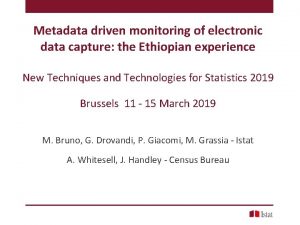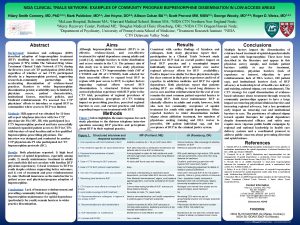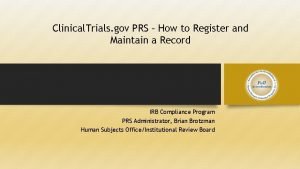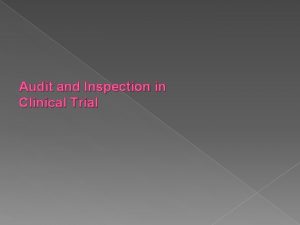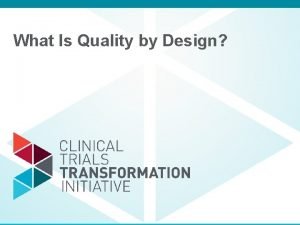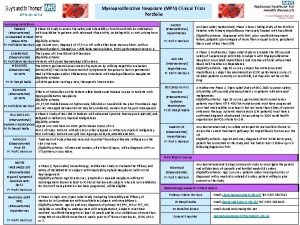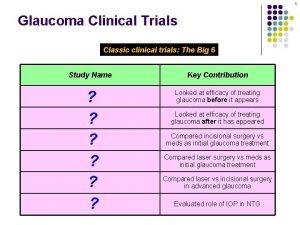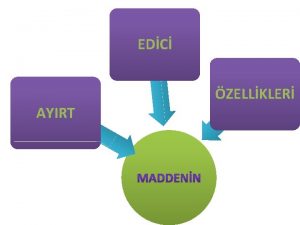Auditing Electronic data capture in clinical trials EDC


















- Slides: 18

Auditing Electronic data capture in clinical trials (EDC) – The auditor’s view Where do auditors see such systems? Regulatory basic documents Key requirements Validation Auditfindings Computer-Systems in hospital and outpatient clinic setting Findings due to technical issues Implementation of a study protocol into an EDC-System Related mistakes following cumbersome data documentation Conclusions Preparation before use of an EDC-System The future EDC_Electronic data capture, Dr. J. -H. Schmidt/RK

Where do auditors see EDC Systems? Patient and volunteer data are increasingly often entered and stored in EDC-systems. Outpatient clinic computers or hospital computer systems will more and more substitute the classic paper patient file. Commercially developed systems as well as self-programmed systems e. g. support of clinical investigations in Clamp-Studies in Diabetes-Research or psychometric tests. During CRO-Audits (e. g. in Clinical Pharmacology units) we see EDC-Systems, which support the study conduct and are used for documentation of data. During investigational site audits special systems for data entry (provided by the pharmaceutical company) are evaluated. EDC_Electronic data capture, Dr. J. -H. Schmidt/RK

Regulatory basic documents Electronic Records, Electronic Signatures – 21 CFR part 11 – March 1997 Annex 11 to GMP guide: Supplementary guidelines for computerized systems – 1992 The application of the principles of GLP to computerized systems – 1995 Guidance for Industry, Computerized Systems used in Clinical Trials – April 1999. FDA Compliance Programm Guidance Manual – Compliance Programm for Sponsors, Contract Research Organisations and Monitors – October 30, 1998 updated February 21, 2001 and Compliance Program for Clinical Investigators – September 2, 1998 International Conference on Harmonisation, Good Clinical Practice: Consolidated Guideline – January 1997 Additional local laws e. g. for Germany: Drug law, data protection law, signature law. EDC_Electronic data capture, Dr. J. -H. Schmidt/RK GAMP (Good Automated Manufacturing Practice)

Valid for: 21 CFR Part 210, 211 58 50, 54, 312, 314 21 CFR Part 11 GMP GLP GCP EDC_Electronic data capture, Dr. J. -H. Schmidt/RK

Valid for: · Applies to all electronic records used to meet Gx. P requirements, including systems for: - Batch records, SOPs, test methods, specs, and policies Chromatography data systems LIMS systems Automated document management systems Inventory records Calibration and preventive maintenance records Validation protocols and reports Training records Customer complaint files Adverse event reporting systems EDC_Electronic data capture, Dr. J. -H. Schmidt/RK

What is an “electric record”? 21 CFR Part 11 – Subpart A, Section 11. 3(6) - Definition: „Electronic record means any combination of text, graphics, data, audio, pictorial, or other information representation in digital form that is created, modified, maintained, archived, retrieved, or distributed by a computer system. “ EDC_Electronic data capture, Dr. J. -H. Schmidt/RK

Archival Requirements · „. . . Electronic records must be archived in electronic form. The electronic records must be protected to enable their accurate and ready retrieval throughout the relevant retention period. . . “ · Keep accurate transcriptions or complete copies of data and „metadata“ on durable media · Keep links between e-signature and electronic document · Tighter controls may be required for „open“ systems (encryption & digital sigs) EDC_Electronic data capture, Dr. J. -H. Schmidt/RK

Key requirements Validation documentation User Support - Adequate validation including Access administration Data Security system Audit Trail Data validation / Systemvalidation - Availability of SOPs - Adequate training for the user - Support “Hotline” of the provider - Only authorized persons receive data entry and access rights - Identifyable users (User ID, Password) - Documentation of system use times - Protection against data manipulation, back-ups and contingency plans - “Human Readability” of data after change - Recording of all datachanges in an audit trail - GAMP validation standard? - Definition of entry checks; plausibility EDC_Electronic data capture, Dr. J. -H. Schmidt/RK checks?

Validation – general documents Corporate validation policy Change control procedure Issues management procedure Document management procedure Validation guidelines Master validation plan Validation maintenance procedure Standard Oerationg Procedures (SOPs) for users End user training manual EDC_Electronic data capture, Dr. J. -H. Schmidt/RK

Validation – concrete steps Definition of functional requirements System specification Software specifications Installation qualification (IQ) Operational qualification (OQ) Performance qualification (PQ) Results and reports for IQ, OQ, PQ Final validation report User acceptance test and release for use EDC_Electronic data capture, Dr. J. -H. Schmidt/RK

Auditfindings (1) Computer /EDC-Systems in hospital and outpatient clinic setting Computerized patient charts in hospitals and outpatient clninics currently do not fulfill the regulatory requirements of EDC-systems as they are designed for another purpose (e. g. for health insurance needs). missing audittrail unlimited acccess for the whole personel of a hospital / outpatient clinic deficient datasecurity missing SOPs and documented training inadequate or missing validation of programs Data entry in the computer requires more time compared to handwritten CRF entries. Adaptability of an EDC-System to the routine workflow is limited. Data entry errors may increase. EDC_Electronic data capture, Dr. J. -H. Schmidt/RK

Auditfindings (2 a) Findings due to technical issues Patient data and measured values can be entered repeatedly. Previous data are altered or deleted without recording in an audittrail. On paper printouts the “print date” in stead of the measurement date is printed. Saving of entered data was not automated leading to loss of data. Data are not adequately secured on the harddisc, e. g. no re-write protection. Manipulation possible. During transfer of laboratory data, units are changed without previous co-ordination, warning or notification. EDC_Electronic data capture, Dr. J. -H. Schmidt/RK

Auditfindings (2 b) Findings due to technical issues While the monitor was logged in to the system the investigator couldn’t work. Data transfer from the investigator to the host of the system wasn’t possible several days. Potential for data loss. EDC_Electronic data capture, Dr. J. -H. Schmidt/RK

Auditfindings (3) Implementation of study protocol in to the EDC-System The parallel work on related CRF-pages was not possible. User unfriendly navigation in the e-CRF leads potentially to higher error rate (motivation decreases). Data were deleted by the system during review process. Computer accepts no calibrated data e. g. from lab devices. Pre-defined data checks are not carried out. EDC_Electronic data capture, Dr. J. -H. Schmidt/RK

Auditfindings (4) Related mistakes following cumbersome data documentation Data were initially documented on paperprint outs. Paper hospital chart, paper-CRF and e-CRF are available. This leads to inconsistencies, more work for the physician, increase of error rate, increase in paper load. Manual entry of data by an investigator e. g. from patient diaries leads to increased error rates (the investigator is not a trained datatypist). Investigators state that they only need 1/3 of time for handwritten documentation compared to electronic entry. EDC_Electronic data capture, Dr. J. -H. Schmidt/RK

Conclusions (1 a) Preparation before use of an EDC-System Before using EDC-systems it has to be ensured that regulatory requirements are met. Quality Assurance can add value to this process. An upfront detailed definition of requirements and their continuous follow up may avoid complications. The procedure of recording of source data in e-trials has to be defined for each center up front. The investigator should be freed from manual entry of lab data or Qol. questionnaires. Professional double data entry minimizes errors. EDC_Electronic data capture, Dr. J. -H. Schmidt/RK

Conclusions (1 b) Preparation before use of an EDC-System Currently investigators see themselves often as datatypists for the sponsor company. The study team and the team at the investigator site need intensive training and supervision before implementation of such a system. The preparedness to work with such a system also at the investigational site as well as the training to use it is vital and decides about succes or failure. An effective hotline and support is vital. EDC_Electronic data capture, Dr. J. -H. Schmidt/RK

Conclusions (2) The Future EDC-Systems should be able in future to import labdata from various sources. The use of EDC systems is currently impeded by problems with portability. Therefor data are not entered directly but have to be documented on paper first. Wireless lans may solve this in the future. EDC-Systems will be used more and more frequently in the future. The resources and expenditure needed, especially at the beginning of a trial are tremendous. An enhanced possibility of adaption of such systems to routine clinical practice is needed. EDC_Electronic data capture, Dr. J. -H. Schmidt/RK
 Electronic data capture rave
Electronic data capture rave Electronic data capture process flow
Electronic data capture process flow Ifta audit manual
Ifta audit manual Auditing computer based information system
Auditing computer based information system Nida clinical trials network
Nida clinical trials network Site initiation visit powerpoint presentation
Site initiation visit powerpoint presentation Clinicaltrials gov api
Clinicaltrials gov api Role of statistician in clinical trials
Role of statistician in clinical trials Andrew nunn
Andrew nunn Randomization
Randomization Phs human subjects and clinical trials information
Phs human subjects and clinical trials information Mpn clinical trials
Mpn clinical trials Hawk irb
Hawk irb Clinical trials
Clinical trials Audits and inspections of clinical trials
Audits and inspections of clinical trials Clinical trials quality by design
Clinical trials quality by design Mpn clinical trials
Mpn clinical trials Dhl clinical trials
Dhl clinical trials Clinical hysteria salem witch trials
Clinical hysteria salem witch trials

